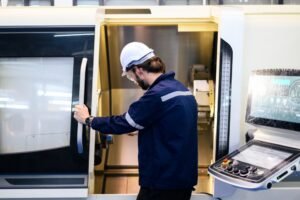Swiss machine tools have long been synonymous with precision engineering, dominating industries that demand micron-level accuracy such as medical device manufacturing, aerospace, and watchmaking. At the heart of this Swiss machine tool technological excellence are two key subsystems: multi-spindle systems and turrets.
These components work synergistically to enable simultaneous multi-operation machining, achieving unprecedented productivity while maintaining Swiss precision standards. Multi-spindle systems enable simultaneous operations at multiple stations, dramatically increasing throughput, while turret systems offer rapid, flexible tool changes and support for powered tools, allowing for intricate and varied machining processes.
Overview of Swiss Machine Tool Multi-Spindle Systems
1. Definition and Development of Multi-Spindle Systems
A multi-spindle system equips a machine tool with several independently controlled spindles, each capable of performing distinct operations in parallel. Imagine an orchestra, where each musician (spindle) plays a different part of the symphony (machining process) simultaneously, creating a seamless performance. This approach slashes cycle times and boosts productivity, especially for high-volume, precision parts.
Over the past decade, advances in servo technology and digital controls have transformed multi-spindle systems from simple mechanical assemblies into smart, adaptive platforms that can handle everything from micro-components to demanding aerospace parts (Modern Machine Shop, 2023).
2. Structure and Components of Multi-Spindle Systems

Modern multi-spindle systems feature moving spindles, high-precision indexing mechanisms, and synchronized servo motors. Moving spindles allow for dynamic positioning, while advanced indexing ensures each spindle is perfectly aligned for its specific operation. Synchronized motors deliver consistent power and reduce vibration, which is critical for maintaining tight tolerances. These elements combine to create a robust system that delivers both speed and accuracy—essential for industries where a fraction of a millimeter can make all the difference.
Analysis of Swiss Machine Tool Turret Systems
1. Basic Structure and Function of Turrets
A turret acts as the tool library and quick-change artist of the Swiss machine tool world. With multiple tool positions, the turret enables the machine to switch between operations—such as turning, drilling, and tapping—without manual intervention. This flexibility is invaluable for complex parts requiring multiple processes in a single setup, reducing downtime and minimizing human error.
2. Coordination of Swiss Machine Tool Turrets and Powered Tools
Turret systems pair seamlessly with powered tools, which provide the torque and speed needed for advanced operations like milling or cross-drilling. By automating tool changes and supporting powered tools, the turret system enables the machine to tackle a broad range of tasks in one cycle. For example, in the electronics industry, turret-equipped Swiss machines can produce intricate connectors in a single pass, eliminating secondary operations and reducing lead times.

Modular and Flexible Configuration of Turret Systems
Turret systems are designed for modularity, allowing users to customize tool positions and types to match their production needs. The Jianke M Series and D Series, for example, offer a variety of turret configurations, making it easy to tailor the machine to your workflow. This adaptability means you can quickly pivot between product lines or scale up production without major retooling.
Synergistic Advantages of Multi-Spindle Systems and Turrets
1. Synchronous Machining and Multi-Station Parallelism Boost Productivity
The combination of multi-spindle systems and turret technology enables true parallel processing—multiple operations on multiple parts, all at once. This synergy can double or even triple output compared to single-spindle machines, especially in environments where time-to-market is critical. By minimizing part transfers and setup times, you can keep your production line moving and your costs in check.
2. Adaptability to Complex Part Machining
Together, multi-spindle and turret systems provide unmatched versatility. Whether you’re producing intricate medical implants or high-volume automotive components, these machines can handle varied geometries and materials without missing a beat. For manufacturers, this means the freedom to pursue new markets and respond quickly to customer demands.
3. Extended Tool Life and Improved Machining Quality
Precision synchronization and intelligent tool management extend tool life and ensure consistent quality. With real-time monitoring and automated adjustments, these systems reduce wear, prevent costly errors, and maintain tight tolerances across long production runs. The result: fewer rejects, lower tooling costs, and happier customers.
4. Typical Application Case Studies
In automotive manufacturing, Swiss machines with multi-spindle and turret systems have been used to cut cycle times for fuel injector components by 35%, while maintaining sub-micron tolerances (Automotive Manufacturing Solutions, 2022). In the medical sector, similar setups have enabled the production of complex bone screws in a single pass, reducing handling and improving traceability.
Comparison with Traditional Single-Spindle/Single-Turret Machines
| Comparison Item | Swiss Multi-Spindle & Turret Machines | Traditional Single-Spindle/Single-Turret Machines |
|---|---|---|
| Machining Efficiency | Multi-station synchronization, high throughput | Single station, lower efficiency |
| Machining Accuracy | Synchronized precision, thermal stability | Accuracy limited by single spindle performance |
| Flexibility | Modular turrets and spindles, quick changeovers | Manual tool changes, less adaptable |
| Application Range | Complex, batch, high-precision parts | Simple, small-batch parts |
| Automation Level | High, supports integrated automation | Limited automation |
For a deeper dive into how our Swiss machines outperform traditional setups, check out our case studies page.
Application of CNC and Intelligence in Multi-Spindle and Turret Systems
Efficient Control by Advanced CNC Systems
Advanced CNC controls orchestrate the entire machining process, ensuring each spindle and turret operates in perfect harmony. Real-time monitoring and adaptive control algorithms optimize tool paths, reduce cycle times, and catch potential issues before they become problems. This level of control is essential for meeting the strict quality standards of industries like aerospace and medical devices.
Swiss Machine Tool CAM Software Support for Programming and Simulation
CAM software, such as Mastercam and GibbsCAM, empowers users to program and simulate complex multi-spindle and turret operations before a single chip is cut. This reduces trial-and-error, shortens setup times, and helps you get products to market faster. Many shops report a 20% reduction in programming time after switching to advanced CAM workflows (CNC Software Inc., 2023).
Intelligent Tool Management and Process Optimization
Intelligent tool management systems track tool wear, predict maintenance needs, and automate tool changes, ensuring your machines run at peak performance. These systems not only extend tool life but also minimize downtime, keeping your shop floor productive and your delivery promises reliable.

Selection and Application Recommendations
How to Choose Multi-Spindle/Turret Configurations Based on Product Characteristics
Selecting the right configuration starts with understanding your product’s geometry, material, and volume requirements. For complex, high-precision parts, opt for more spindles and turret positions. For high-volume, repetitive production, prioritize automation and quick-change capabilities. Not sure where to start? Our technical experts are ready to help—contact us now admin@jiankemach.com for a free, personalized consultation.
Industry Application Case Sharing
Across industries, Swiss multi-spindle and turret systems have enabled manufacturers to achieve breakthroughs in efficiency and quality. Electronics firms, for example, have used these machines to produce micro-connectors with zero defects over million-part runs. Medical device companies have leveraged them to deliver patient-critical components with full traceability and compliance. These real-world successes can inspire your next project.
Future Technology Development Trends
Looking ahead, multi-spindle and turret technologies are poised to become even smarter and more connected. With artificial intelligence and IoT integration, future machines will offer predictive maintenance, autonomous optimization, and seamless integration with digital factories. Staying ahead of these trends will help you maintain a competitive edge.
Multi-spindle systems and turret technology are the engine behind Swiss machine tools’ reputation for precision and productivity. By leveraging these innovations, manufacturers can boost throughput, enhance quality, and adapt quickly to changing market demands. As technology evolves, Swiss machine tools will continue to set the standard for advanced manufacturing. Ready to take your operations to the next level? Visit our Swiss machine tool product center or Contact Us today to find the solution that fits your business.





